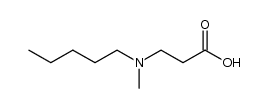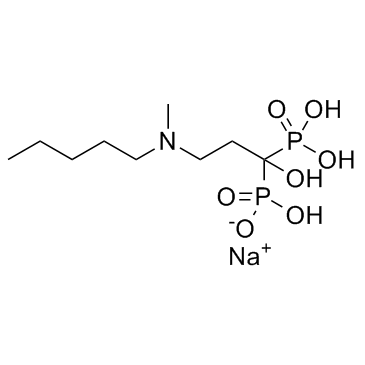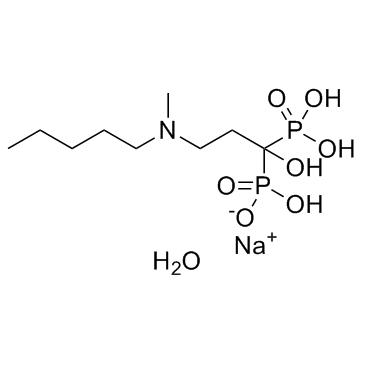114084-78-5
| Name | Ibandronate |
|---|---|
| Synonyms |
{1-Hydroxy-3-[methyl(pentyl)amino]propane-1,1-diyl}bis(phosphonic acid)
Bondronat [1-hydroxy-3-[methyl(pentyl)amino]-1-phosphonopropyl]phosphonic acid ibandronic acid Ibandronic acid [BAN:INN] phosphonic acid, 1-hydroxy-3-(methylpentylamino)propylidenebis- (1-Hydroxy-3-(methylpentylamino)propylidene)bisphosphonic acid {1-Hydroxy-3-[methyl(pentyl)amino]-1,1-propanediyl}bis(phosphonic acid) {1-hydroxy-3-methyl(pentyl)aminopropane-1,1-diyl}bis(phosphonic acid) Phosphonic acid, [1-hydroxy-3-(methylpentylamino)propylidene]bis- (1-Hydroxy-3-(methyl(pentyl)amino)propane-1,1-diyl)diphosphonic acid |
| Description | Ibandronic acid is a highly potent nitrogen-containing bisphosphonate used for the treatment of osteoporosis.Target: OthersIbandronate (1.25-2 μM) significantly reduces endothelial cell growth, while ibandronate (2 μM) also significantly reduces capillary-like tube formation and increases apoptosis of endothelial cells. Ibandronate (< 100 μM) dose-dependently increases VEGF expression in endothelial cells [1]. Ibandronate (< 100 μM) inhibits growth of both prostate cancer cell lines (LNCaP and PC-3) in a dose dependent manner [2].Ibandronate administered either daily (2.5 mg) or intermittently (20 mg every other day for 12 doses every 3 months) significantly reduces the risk of new morphometric vertebral fractures by 62% and 50% (p = 0.0006), respectively, in osteoporotic women after 3 years' treatment. Ibandronate administered either daily (2.5 mg) or intermittently (20 mg every other day for 12 doses every 3 months) significantly and progressively increases BMD of lumbar spine by 6.5% and 5.7%, respectively, in osteoporotic women after 3 years' treatment [3]. Ibandronate (< 125 mg/kg s.c.) results in a dose dependent increase in bone mineral density (BMD), trabecular bone volume and trabecular number, load to failure (Fmax), and yield load in long bones and vertebrae in ovariectomized rats, and increased trabecular separation in ovariectomized rats is fully prevented by all doses [4]. |
|---|---|
| Related Catalog | |
| References |
| Density | 1.5±0.1 g/cm3 |
|---|---|
| Boiling Point | 587.8±60.0 °C at 760 mmHg |
| Melting Point | 113-115ºC |
| Molecular Formula | C9H23NO7P2 |
| Molecular Weight | 319.229 |
| Flash Point | 309.3±32.9 °C |
| Exact Mass | 319.094971 |
| PSA | 158.15000 |
| LogP | -0.65 |
| Vapour Pressure | 0.0±3.7 mmHg at 25°C |
| Index of Refraction | 1.538 |
| Storage condition | -20°C Freezer |
| HS Code | 2931900090 |
|---|
|
~6% 
114084-78-5 |
| Literature: Journal of Medicinal Chemistry, , vol. 45, # 17 p. 3721 - 3738 |
| Precursor 1 | |
|---|---|
| DownStream 2 | |
| HS Code | 2931900090 |
|---|---|
| Summary | 2931900090. other organo-inorganic compounds. VAT:17.0%. Tax rebate rate:13.0%. Supervision conditions:AB(certificate of inspection for goods inward,certificate of inspection for goods outward). MFN tariff:6.5%. General tariff:30.0% |


